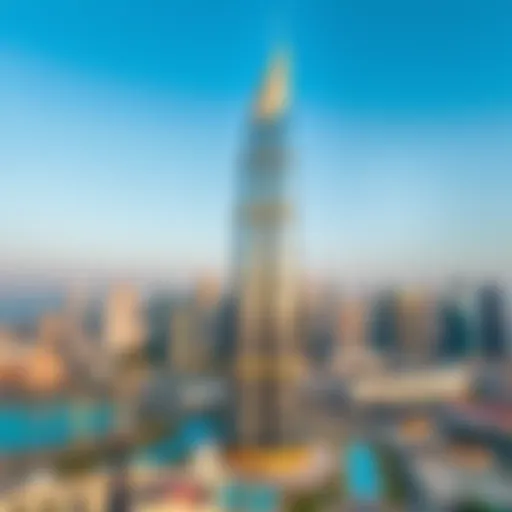Exploring Sheikh Zayed Road: A Detailed Perspective
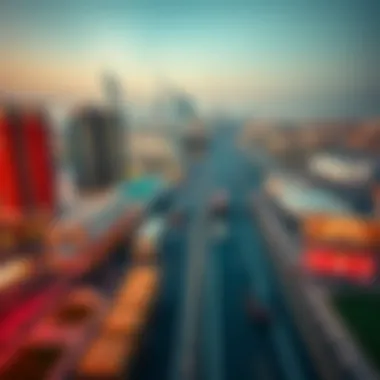

Intro
Sheikh Zayed Road, often seen as the lifeblood of modern Dubai, paints a vivid picture of the city’s identity and economic drive. This major traffic artery stretches from Trade Centre Roundabout to the Abu Dhabi border, linking dynamic districts and areas bursting with life and opportunity. As one travels along this bustling thoroughfare, it becomes clear that the road is much more than just a path; it’s a testament to Dubai's rapid growth and development.
This article offers a deep dive into the significance of Sheikh Zayed Road. The thoroughfare is pivotal in connecting various districts within Dubai while serving as the backbone for the emirate's real estate market. With tall skyscrapers rising dramatically alongside its lanes, the area attracts both investors and tourists. From sprawling shopping centers like The Dubai Mall to corporate offices, every corner along Sheikh Zayed Road tells a unique story of commerce and culture.
As we navigate the complexities of this iconic road, we'll discuss its impact on property markets, essential guidelines for buying and selling, and forecast potential trends that could shape the future landscape of Dubai.
Get ready to explore every intricate detail of Sheikh Zayed Road and understand why it remains a focal point for developers and investors alike.
Preamble to Sheikh Zayed Road
Sheikh Zayed Road is not merely a road; it’s a lifeline for Dubai, embodying the dynamic essence of the emirate’s rapid evolution. This bustling highway stretches across the city, facilitating trade, commerce, and tourism while serving as a pivotal link between the prominent districts of Dubai. As an investor or a stakeholder in real estate, one can hardly overlook the significance of this arterial route. Understanding its multifaceted role is essential in making informed decisions within the fast-paced market of Dubai.
Historical Context
The story of Sheikh Zayed Road traces back to the late 20th century, with its development marking a turning point in Dubai's infrastructure. Originally a modest two-lane road, it has transformed into a sprawling thoroughfare teeming with high-rises and commercial establishments. The road’s development was pushed by the vision of Sheikh Zayed bin Sultan Al Nahyan, who aimed to modernize not only the roadways but also the economic landscape of the region. This change wasn’t just about asphalt and concrete; it was about fostering growth and attracting global investments.
The boom in economic activity along Sheikh Zayed Road mirrors Dubai's accelerated urbanization during the late 1990s and early 2000s. Concerted efforts to enhance accessibility led to the development of iconic structures like the Burj Khalifa and the Dubai Mall, which now stand as symbols of luxury and ambition. This historical backdrop not only informs us of how far Dubai has come but also provides insights into future trajectories.
Strategic Importance
Sheikh Zayed Road's strategic importance can’t be overstated. It serves as the main artery connecting key neighborhoods and business districts, like the Dubai International Financial Centre and Business Bay. This central positioning makes it essential for daily commuting, facilitating the movement of workers and tourists alike.
With heavy traffic volumes, the road is often a point of congestion during peak hours, highlighting its role as a central hub within Dubai’s transport network. However, its wide lanes and ongoing upgrades signal a commitment to improving flow and connectivity.
Additionally, for investors, the vicinity along this road is a hotbed of opportunities. Properties here tend to command premium prices, not only due to their location but because of the ongoing developments promising to boost the value of real estate. A residential or commercial property situated on or near Sheikh Zayed Road ensures visibility and accessibility, proving to be a wise investment choice.
"The strategic location of Sheikh Zayed Road places it at the very heart of Dubai’s transformation into a global city."
As we delve deeper into the narrative of Sheikh Zayed Road, understanding its historical and strategic contexts will provide a solid foundation for exploring its various dimensions—from architectural marvels to economic impacts.
Urban Development Along Sheikh Zayed Road
The role of urban development along Sheikh Zayed Road cannot be overstated. This thoroughfare has become a beacon of economic activity and urbanization in Dubai. From glistening skyscrapers to vibrant residential communities, the landscape is ever-evolving, marking the transformation of an arid desert into a bustling urban environment that draws attention from investors and tourists alike.
The strategic position of Sheikh Zayed Road is crucial. It links various key areas of Dubai, facilitating not just the flow of traffic but the movement of ideas and commerce. As such, each development project along this road is typically a reflection of broader economic trends and aspirations in the emirate. For stakeholders like investors and developers, understanding the dynamics of urban development along Sheikh Zayed Road is essential. It reveals potential areas of growth and helps forecast future trends in real estate and commerce.
Commercial Hub
Sheikh Zayed Road stands as a pulse for commercial activity in Dubai. It hosts many businesses ranging from multinational corporations to innovative start-ups. The road is dotted with premier office spaces that cater to the demands of modern businesses, making it a prime location for companies looking to establish a foothold in the region.
The Dubai World Trade Centre and several other corporate campuses along the road are testimonies to its commercial importance. These landmarks regularly host exhibitions and conferences that attract participants from around the globe, further solidifying the area as a pivotal business hub.
Moreover, proximity to transport links, like the Dubai Metro, enhances accessibility for clients and employees, making it an attractive option for firms considering relocation or expansion. The steady increase in foot traffic significantly contributes to the revenue potential for businesses, fostering an environment ripe for networking and collaboration.
Additionally, the road is the backbone for retail developments. Malls and markets, such as Dubai Mall or Mall of the Emirates, are not far off, offering an integrated mix of shopping, dining, and entertainment venues that complement the commercial spaces. This synergy further elevates Sheikh Zayed Road's appeal as a business address.
Residential Projects
The residential landscape along Sheikh Zayed Road is equally impressive, reflecting modern living merged with luxurious style. High-rise apartments and gated communities have sprung up, providing housing options for a diverse demographic, from expatriates to affluent locals. Developments like Burj Khalifa, although slightly off the road itself, exemplify the high living standard and exclusivity that residential offerings in this area promise.
These projects often prioritize amenities such as parks, gyms, and community centers, appealing to buyers seeking a balanced lifestyle. Many new complexes also incorporate smart home technologies, which resonate well with tech-savvy homeowners.
Furthermore, the proximity to essential services—from schools to hospitals—makes these residential areas particularly desirable. Families and young professionals alike find the ease of access to both work and leisure appealing.
In light of ongoing expansion, there are several proposed projects aimed at enhancing the residential offerings along Sheikh Zayed Road. They promise not only to provide more living spaces but also to contribute to the urban fabric, ensuring sustainability and aesthetic appeal—from eco-friendly designs to innovative urban planning.
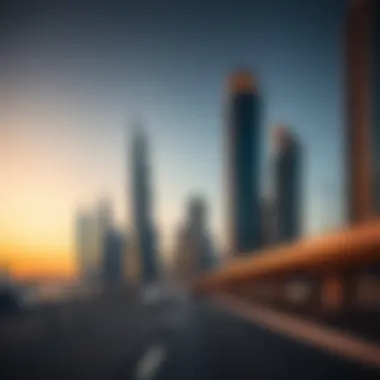

"Investing in properties along Sheikh Zayed Road signifies not just a purchase, but a commitment to a lifestyle grounded in opportunity and growth."
Ultimately, as urban development continues along Sheikh Zayed Road, it stands at the intersection of commerce, luxury living, and cultural diversity, making it a focal point for anyone interested in the vibrant pulse of Dubai's ever-evolving landscape.
Architectural Significance
Sheikh Zayed Road is not only a thoroughfare in Dubai, it’s a living canvas of architectural brilliance and urban planning that reflects the emirate’s rapid development and global aspirations. The significance of this road goes beyond just transportation; it serves as a showcase for the dynamic interplay of tradition and modernity in architecture.
Iconic Structures
The skyline along Sheikh Zayed Road is punctuated with iconic buildings that have become symbols of Dubai’s growth. You can’t miss the Burj Khalifa, the tallest building in the world, towering above all else. Its sleek, needle-like form is reflective of the aspirations of a city that aims for the stars.
Another standout is the Emirates Towers, a pair of skyscrapers that embody the blend of functionality and artistry. These buildings house offices, hotels, and a shopping mall, serving both commercial and leisure needs.
Several other structures add to the architectural richness of the road, such as the twisted silhouette of the Cactus Tower and the luxurious Burj Al Arab. Each of these buildings has not only transformed the landscape but also enhanced the cultural identity of Dubai. These standout structures attract tourists and investors alike, creating a synergy that boosts local economies.
"The architectural marvels along Sheikh Zayed Road are not just buildings; they symbolize the aspirations and ambitions of a city that aims to be a global player."
Design Philosophy
The design philosophies embodied in the architecture along Sheikh Zayed Road are deeply rooted in both innovation and sustainability. More than mere aesthetics, the designs take into account climate considerations and the need for durability in a harsh environment.
Modern architects draw inspiration from traditional Islamic art, which infuses intricate patterns and designs into contemporary forms. This approach creates a unique identity that resonates with both locals and visitors.
Sustainable design elements are also becoming increasingly important. Green building practices are utilized in many new structures; for instance, the use of energy-efficient glass reduces the need for air conditioning, contributing to lower energy consumption. The integration of sustainable materials displays a commitment to environmental responsibility.
With transport infrastructures such as dedicated public transport lines and pedestrian walkways incorporated into design plans, the buildings along Sheikh Zayed Road foster a sense of community while enhancing usability.
In summary, the architectural significance of Sheikh Zayed Road is multifaceted, encompassing aesthetic appeal, cultural representation, and sustainability. It’s a space where innovation thrives and tradition is respected, making it an essential reference point for investors, developers, and anyone interested in the architectural landscape of the Gulf.
Cultural Impact of Sheikh Zayed Road
The cultural impact of Sheikh Zayed Road is one of those unsung stories that typically gets overshadowed by its architectural marvels and economic significance. However, it is in this very cultural narrative that you find the heartbeat of Dubai, alive and thriving against the backdrop of this iconic avenue. From art installations to educational centers, the cultural landscape along Sheikh Zayed Road presents a palette that broadens the understanding of the Arab identity and fosters community engagement.
Cultural Institutions and Landmarks
Sheikh Zayed Road hosts several cultural institutions that resonate deeply not only with Dubai locals but also with international visitors. The Dubai Opera, positioned near the Burj Khalifa, stands as a beacon for the performing arts. Its striking architecture and diverse programming, from operas to ballet, provide a platform for cultural exchange. This venue isn't just a building; it's a cultural hub where different backgrounds collide and mingle.
Another pivotal landmark is the Jumeirah Mosque, constructed in the medieval Fatimid tradition, which attracts visitors seeking to understand Islamic culture. Guided tours welcome non-Muslims to explore and learn about Islam in a friendly environment. This interaction helps demystify misconceptions and fosters a more comprehensive understanding of the Emirati way of life.
A lesser-known, but equally significant cultural spot is the Dubai Design District (d3). This area emphasizes sustainability and innovation in design, drawing in creative minds through its workspace offerings and art installations, which often reflect the modern UAE's ethos. Not only does it showcase local talent, but it also attracts global designers, enhancing Dubai's reputation as a growing cultural capital.
"Culture is the DNA of any city. Sheikh Zayed Road is the bloodstream feeding that DNA with art, music, and shared stories."
Festivals and Events
The vibrancy of Sheikh Zayed Road is further amplified through various festivals and events throughout the year. These gatherings celebrate everything from Emirati heritage to global cultural influences, reinforcing Dubai's status as a melting pot of traditions. During the Dubai Shopping Festival, the road transforms into a lively boulevard filled with activities, street performances, and parades that showcase local and international talents. This festival not only serves commercial interests but also promotes community spirit and festive joy.
Equally captivating are the UAE National Day celebrations, where the road becomes a canvas for UAE pride. From elaborate fireworks displays to traditional parades featuring folk performances, the celebrations pull people from all walks of life together in harmony, showcasing the richness of Emirati culture.
Moreover, the Dubai Film Festival, held annually near Sheikh Zayed Road, offers a unique platform for filmmakers and creatives to showcase their work. Though it spans various venues, the road's accessibility and allure ensure a high footfall, enhancing the carnival-like atmosphere.
In summary, the cultural landscape along Sheikh Zayed Road serves as a critical connect between Dubai’s past and future. The institutions and events encapsulate a blend of tradition and modernity, creating an engaging space for all who travel this famed artery. Understanding this aspect becomes essential for anyone looking to delve deeper into what Sheikh Zayed Road truly embodies.
Economic Contribution
Sheikh Zayed Road stands as a cornerstone of Dubai's economic framework, acting as the thread that weaves together various sectors from commerce to real estate. This prominent thoroughfare not only facilitates seamless movement but also significantly boosts business growth and investment potential—all of which are vital for nurturing the emirate’s burgeoning economy. In a city renowned for its ambition and rapid development, understanding the economic pulsations of Sheikh Zayed Road is paramount.
Driving Business Growth
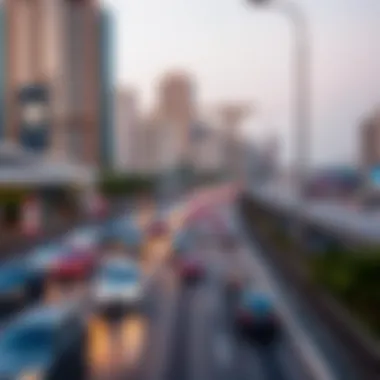

One cannot overlook how Sheikh Zayed Road serves as a bustling commercial artery. With its array of retail outlets, corporate offices, and premium hotels, this stretch of road drives a great level of business activity. Major companies, both local and multinational, have established their headquarters along this corridor, making it a hub for networking and enterprise.
For instance, the presence of colossal skyscrapers such as the Burj Khalifa and the Emirates Towers does not just contribute to the skyline but creates a vibrant ecosystem for corporate engagements. Businesses thrive here due to high visibility and easy access, allowing them to attract clients and talent alike. This favorable environment promotes not only job creation but also stimulates innovation, as companies seek to keep up with the competitive landscape.
The road's strategic location enhances its role as a conduit for logistics and trade. From warehouse distribution to regional supply chains, companies benefit from proximity to major business centers and the Dubai International Airport. Ultimately, Sheikh Zayed Road is not merely a roadway; it’s a launchpad for entrepreneurial aspirations, which propels the emirate's economy ever forward.
Investment Opportunities
Investors looking at Sheikh Zayed Road are greeted by a wealth of opportunities. With continuous development and urban growth, this thoroughfare has transformed into a prime real estate market. Properties along and adjacent to Sheikh Zayed Road offer both commercial and residential prospects that attract keen interest from investors.
Real estate developments such as the Dubai Marina and Business Bay exemplify the lucrative investment potential. Prices have seen a steady rise, and many projects are tailored to meet the demands of a diverse demographic, offering various options from luxury apartments to office spaces. Investors are showing an increasing appetite for properties that promise high returns, thanks to the sustained economic boom powering Dubai.
Moreover, various government initiatives are boosting investment allure in the area. The UAE government is keen on enhancing the infrastructure around Sheikh Zayed Road, including smart initiatives that will integrate technology into everyday commuting and connectivity. As a result, making investments here not just seems a sound financial decision but a forward-looking investment in a progressively innovative environment.
Transport and Infrastructure
Understanding the transport and infrastructure surrounding Sheikh Zayed Road is essential, given its role as the lifeblood of one of the most dynamic cities in the world. This road stands as a testament to Dubai’s ambition, effectively connecting various segments of the city while facilitating trade and mobility. The integration of advanced infrastructure has made this thoroughfare not just a means of transportation but a strategic corridor that enhances overall urban functionality.
Road Networks and Connectivity
The road networks branching off Sheikh Zayed Road are intricately designed to ensure seamless flow of traffic, reflecting urban planning at its finest. The direct access to both residential and commercial areas means that one can travel from the bustling heart of Dubai to quieter neighborhoods with relative ease.
- Major Junctions: Key intersections, such as the Dubai Marina interchange and the Trade Center roundabout, serve as vital connectors, reducing congestion and improving accessibility. These junctions are equipped with modern traffic signal technology, optimizing vehicle movement.
- Proximity to Landmarks: The road's alignment allows for unprecedented connectivity to landmarks such as the Burj Khalifa and Dubai Mall. This not only enhances daily commuting but also boosts foot traffic in commercial areas, thus benefiting businesses.
- Future Expansion Plans: There are ongoing discussions regarding the possible expansion of minor roadways branching off Sheikh Zayed Road to further ease traffic and accommodate increasing commuter numbers. This foresight is indicative of a growing metropolis that values mobility.
"A well-maintained road network is crucial for urban development, influencing economic productivity in major cities like Dubai."
Public Transport Integration
As Dubai strides towards a more sustainable future, the integration of public transport along Sheikh Zayed Road plays a pivotal role. With both metro and bus services in place, the connectivity further strengthens the road's importance. This is particularly vital in a city where the expectation of movement is ever-increasing.
- Dubai Metro: The Red Line of the Dubai Metro runs parallel to Sheikh Zayed Road, creating an efficient and rapid transit option. Stops near key commercial and residential areas mean that even during peak hours, commuters can avoid gridlock by opting for the metro.
- Buses and Taxis: An extensive bus network, complemented by widespread taxi services, adds layers of connectivity. Airport shuttles, express buses, and ride-sharing services ensure that reaching any point along the road—or even beyond—is both convenient and hassle-free.
- Smart Initiatives: Innovative ticketing systems and real-time tracking are also in place, making public transport more user-friendly. Such initiatives aim to enhance the travel experience and encourage more people to rely on public transit options instead of private vehicles.
In summary, the transport and infrastructure developments surrounding Sheikh Zayed Road reflect a broader vision for urban living. The strategic design of road networks coupled with integrated public transport systems creates a robust framework that supports not only resident mobility but also furthers economic growth and sustainability in Dubai’s ever-evolving landscape.
Environmental Considerations
Environmental considerations embedded within the development along Sheikh Zayed Road are crucial in steering the road towards a sustainable future. As a primary artery of Dubai, it bears not only economic weight but also ecological responsibilities. The balance between urbanization and environmental sustainability is vital.
Sustainability Initiatives
Sustainability is not just a buzzword; it has become a way of life in Dubai, particularly regarding Sheikh Zayed Road. Various initiatives aim to make this bustling thoroughfare greener. For one, developers have started integrating energy-efficient building practices into their projects. This aligns with Dubai's broader vision to reduce carbon emissions.
Another noteworthy initiative is the use of solar energy. Solar panels are increasingly being installed in commercial buildings along the road. This helps in harnessing natural energy while decreasing reliance on fossil fuels. Moreover, the government has rolled out programs to promote electric vehicles. Well-designed charging stations are becoming a common sight, making it easier for drivers to choose eco-friendly alternatives.
Cities around the world provide inspiration for Dubai. For example, Copenhagen has successfully implemented bike-sharing programs. Similarly, Dubai is looking into cycling paths along Sheikh Zayed Road to encourage healthier commuting options for its residents.
Green Spaces and Urban Planning
When urban planning occurs with the environment in mind, the results can be transformative. Along Sheikh Zayed Road, the inclusion of green spaces has been thoughtfully considered. Parks and landscaped areas contribute to a reduction in urban heat. They also enhance the aesthetic appeal of the road, making it a more attractive destination for both residents and tourists.
The Dubai authorities understand the importance of green spaces. With green architecture on the rise, it offers dual benefits—environmental enhancement and recreational spaces for the community. For instance, parks such as Zabeel Park provide a welcome respite amidst the concrete landscape.
Furthermore, plans are underway to improve the connectivity of these green spaces. Walking paths and bike lanes are being designed to connect residents and visitors with parks seamlessly. This fosters an environment where outdoor activities flourish, promoting a healthier lifestyle while maintaining environmental integrity.
"A greener urban environment leads to a happier citizenry."
In wrapping up, the environmental considerations surrounding Sheikh Zayed Road reveal a concerted effort to ensure urban expansion doesn't come at the expense of nature. By investing in sustainability initiatives and enhancing green spaces, Dubai is making strides toward an eco-friendly future.
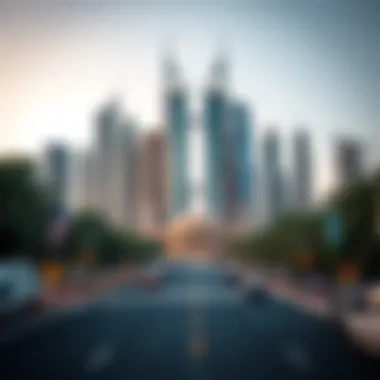

Tourism and Attractions
Tourism along Sheikh Zayed Road is not just an add-on to the Emirate's economy; it plays a pivotal role in highlighting Dubai's blend of modernity and tradition. The road serves as more than a mere conduit for vehicles; it is a vibrant artery, pulsing with the energy of travelers and locals alike. Visitors are often enchanted by how sheikh Zayed Road resembles a grand stage where Dubai unveils its most exciting attractions. The significance of this thoroughfare in the tourism sector cannot be overstated, as it directly influences foot traffic to hotels, entertainment venues, and shopping districts nearby.
Notable Attractions Along the Road
Sheikh Zayed Road provides easy access to a variety of urban marvels. Among the noteworthy attractions is the Burj Khalifa, the tallest building in the world. Towering above everything, it draws a constant parade of tourists eager to scale its dizzying heights. Dubai Mall, located just beneath this architectural masterpiece, is another major highlight. With its vast array of shops, gourmet restaurants, and even an aquarium, it’s often referred to as a shopping paradise.
- Dubai World Trade Centre: A business hub and host for various exhibitions and conferences.
- Al Farooq Omar Mosque: An architectural gem that provides insight into Islamic culture and hospitality.
- The Museum of the Future: This cutting-edge space not only showcases futuristic innovations but also engages visitors in thought-provoking topics like sustainability and technology.
In addition to these landmarks, the road is lined with luxurious hotels, like the JW Marriott Marquis and Shangri-La, elevating the stay experience for visitors. Amidst these diverse attractions, you will find numerous dining options ranging from local Emirati cuisine to global dishes, catering to all palates.
Impact on Local Tourism
The influence of Sheikh Zayed Road on local tourism is profound. The accessibility it provides significantly boosts visitor numbers to surrounding attractions, thus enhancing the overall tourism footprint in Dubai. Furthermore, the cultural significance of the road cannot be overlooked. It hosts numerous events and exhibitions that draw international crowds, thereby supporting local businesses and promoting the Emirate's image worldwide.
The road caters not only to leisure travelers but also business professionals attending conferences at venues like the Dubai International Convention and Exhibition Centre. This dual demographic boosts spending in various sectors, from dining to entertainment, indirectly benefiting the real estate market as well.
"Tourism is not merely an industry in Dubai; it is the heartbeat of the city's socio-economic fabric."
As investments continue to pour into developments along Sheikh Zayed Road, its relevance for tourism will only grow. Stakeholders in the real estate market must keep a close eye on the trends to tap into the expanding tourist base efficiently. This makes the road an essential chapter for anyone looking to understand Dubai's evolving landscape.
Future Prospects
As Sheikh Zayed Road continues to develop and evolve, its future prospects paint a promising picture informed by strategic foresight and innovative ideas. This key thoroughfare not only supports the existing urban landscape of Dubai but also signals potential growth trajectories that stand to enhance economic activity, connectivity, and the quality of life for its inhabitants. Investors, developers, and stakeholders in the real estate market are especially attuned to these developments, as the implications are far-reaching.
Projected Developments
Looking ahead, Sheikh Zayed Road is set to undergo significant transformations that cater to the growing needs of Dubai’s residents and businesses. Several projected developments illuminate the future:
- Expansion of Infrastructure: The road's infrastructure will be further optimized, accommodating increasing traffic and ensuring smoother commutes. This includes the implementation of smart traffic management systems that adapt to real-time conditions.
- Mixed-Use Complexes: Upcoming projects will focus on mixed-use developments that combine residential, commercial, and recreational spaces. These complexes are designed to create vibrant communities, offering residents convenience just a stone's throw away from their homes.
- Smart City Initiatives: Embracing the vision of a smart city, Sheikh Zayed Road will integrate advanced technologies for sustainability. This may include energy-efficient buildings and eco-friendly transportation options.
The future isn't just bright; it's dynamic, filled with opportunities that align with Dubai's ambitious growth plans.
Technological Advancements
Technology will play a pivotal role in shaping the future of Sheikh Zayed Road. Several advancements are set to revolutionize how the road functions and how people interact with it:
- Autonomous Vehicles: With the rise of autonomous driving technology, there's the potential for a dedicated lane on Sheikh Zayed Road for self-driving cars. This could significantly reduce traffic congestion and redefine transportation norms.
- Digital Infrastructure: Enhanced digital connectivity through high-speed internet and 5G networks will support businesses and services along the road, creating a more interactive environment for visitors and residents.
- Green Technologies: Expect to see increased use of green technologies in construction and urban planning. Solar panels, green roofs, and sustainable materials will gain traction, ensuring that development along the road is environmentally responsible.
The infusion of these technological advances into the landscape of Sheikh Zayed Road not only aligns with global trends but also positions Dubai as a benchmark for future urban development. Investors and stakeholders should keep a keen eye on these trends, as they can inform strategic investments and development decisions.
Epilogue
Unpacking the various dimensions of Sheikh Zayed Road reveals its vital role in the fabric of Dubai's urban environment. Understanding this principal highway not only illuminates its physical presence but also highlights the facets that make it a cornerstone of economic activity, architectural ingenuity, and cultural identity.
Summary of Insights
Since its inception, Sheikh Zayed Road has morphed from a simple thoroughfare into a bustling artery that connects numerous neighborhoods, commercial centers, and attractions. Key insights from our exploration include:
- The road's historical context and its rapid development, which mirrors Dubai's transformation from a modest trading port to a global metropolis.
- The architectural features that define Sheikh Zayed Road, showcasing a blend of modernism and cultural motifs that speak to both tradition and forward-thinking.
- The road’s multifaceted economic impact, serving as a catalyst for businesses, attracting shoppers and travelers alike.
- An emphasis on sustainable practices and integration of green spaces along urban planning initiatives, revealing a conscious effort towards environmental stewardship.
These dimensions combine to portray Sheikh Zayed Road as not merely a transit route, but a significant component of Dubai's identity.
The Road Ahead
Looking into the future, the trajectory of Sheikh Zayed Road remains dynamic. Projected developments suggest that infrastructural enhancements and technological advancements will redefine the user experience further. Some key considerations include:
- Smart transportation integrations: Initiatives focusing on real-time data analytics and electric mobility solutions aim to streamline traffic flow and enhance accessibility along the road.
- Sustainable urban growth: More projects will aim for eco-friendly designs, integrating technology for energy efficiency and sustainability practices.
- Continued cultural enlivenment: Future events and cultural shows are set to enhance community engagement, reinforcing the road's status as a cultural epicenter.
In essence, the road ahead promises growth not just in terms of economic metrics but in enriching the experience of all who traverse Sheikh Zayed Road. The ongoing journey of this roadway reflects a broader narrative about Dubai itself – one of constant evolution and adaptation.
"Understanding the past and looking towards the future is essential to navigate the path of growth."
As stakeholders from various sectors look towards the horizon, navigating the opportunities rich within Sheikh Zayed Road will be paramount for sustained success in the years ahead.



